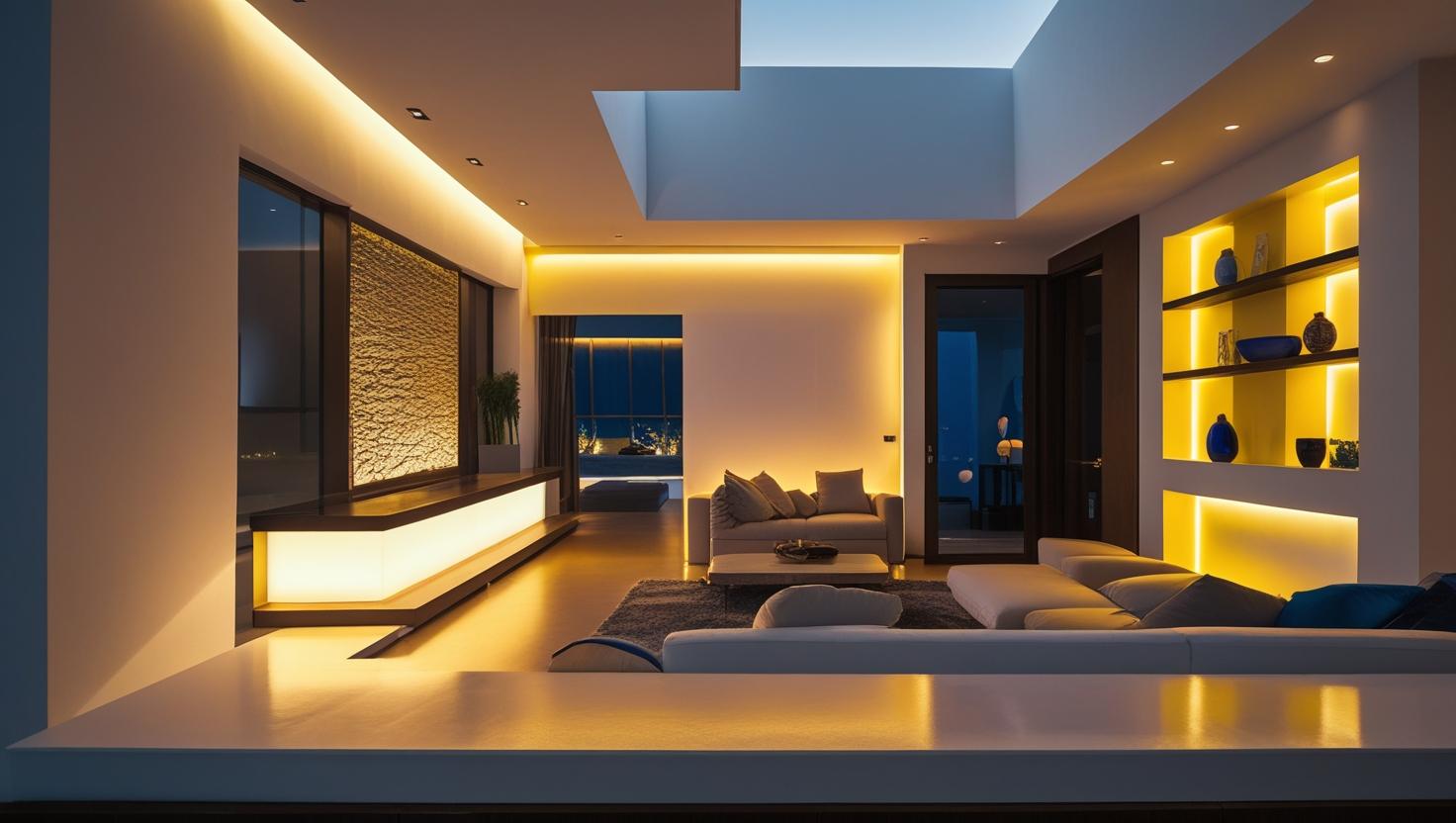The global lighting industry is undergoing a transformative shift, with smart lighting emerging as a cornerstone of modern energy-efficient and technologically advanced solutions. As urban landscapes evolve and consumer preferences lean toward sustainability and convenience, the smart lighting market is witnessing unprecedented growth. Understanding the key drivers of the smart lighting market is essential to grasp the forces propelling this sector forward. This article delves into the intricate factors fueling the smart lighting industry’s expansion, offering insights into technological advancements, consumer trends, and global initiatives that are shaping its future.

The Rise of Energy Efficiency as a Core Driver in the Smart Lighting Market
One of the most significant key drivers of the smart lighting market is the increasing demand for energy-efficient solutions. With global energy consumption on the rise, governments, businesses, and consumers are prioritizing technologies that reduce electricity usage and environmental impact. Smart lighting systems, particularly those utilizing LED technology, consume significantly less energy than traditional incandescent or fluorescent lighting.
The integration of sensors and automated controls further enhances energy efficiency by enabling lighting systems to adjust based on occupancy, ambient light, or time of day. For instance, smart lights can dim or turn off automatically in unoccupied spaces, minimizing energy waste. This capability aligns with global sustainability goals, as governments worldwide implement stricter regulations to curb energy consumption and greenhouse gas emissions. The push for eco-friendly solutions is a pivotal force among the key drivers of the smart lighting market, encouraging widespread adoption across various sectors.
Integration of IoT and Connectivity Technologies Revolutionizing Smart Lighting
The advent of the Internet of Things (IoT) has revolutionized the lighting industry, serving as a critical component among the key drivers of the smart lighting market. IoT-enabled smart lighting systems allow for seamless connectivity, enabling users to control and monitor lighting remotely through smartphones, tablets, or voice assistants like Amazon Alexa and Google Assistant. This connectivity transforms static lighting fixtures into intelligent networks capable of automation, scheduling, and real-time adjustments.
Wireless communication protocols such as Zigbee, Z-Wave, and Bluetooth have advanced significantly, facilitating scalable and flexible installations. These technologies enable smart lighting systems to integrate with broader smart home or smart city ecosystems, creating interconnected environments that enhance convenience and efficiency. For example, smart streetlights in urban areas can be programmed to adjust brightness based on traffic patterns or weather conditions, optimizing energy use while improving safety. The growing adoption of IoT technologies is a transformative force, solidifying its position as one of the key drivers of the smart lighting market.
Smart City Initiatives Fueling the Expansion of Smart Lighting Solutions
The global proliferation of smart city projects is another major factor among the key drivers of the smart lighting market. As cities worldwide strive to become more sustainable and efficient, smart lighting is becoming an integral component of urban infrastructure. Smart streetlights, for instance, are being deployed to reduce energy consumption, enhance public safety, and improve urban planning.
Smart cities leverage connected lighting systems to gather data on environmental conditions, such as humidity or CO2 levels, which can inform municipal decisions and improve infrastructure management. The integration of smart lighting with other city systems, such as traffic signals and power meters, creates a robust sensing network that supports data-driven urban development. This alignment with smart city goals underscores the importance of smart lighting as a key driver of the smart lighting market, particularly in rapidly urbanizing regions like Asia Pacific.
Consumer Demand for Personalization and Aesthetics in Smart Lighting
The rising consumer demand for personalized and aesthetically pleasing lighting solutions is a significant contributor to the key drivers of the smart lighting market. Smart lighting systems offer unparalleled customization, allowing users to adjust color temperatures, brightness levels, and even lighting hues to suit their preferences or moods. Features like color-changing capabilities and tunable white light have made smart bulbs increasingly popular in residential and commercial settings, enhancing both functionality and ambiance.
In residential spaces, consumers are drawn to the ability to create mood lighting or automate lighting schedules to align with daily routines. For instance, smart lights can simulate natural daylight to improve well-being or create vibrant lighting schemes for social gatherings. In commercial environments, businesses use smart lighting to enhance customer experiences, such as in retail stores where lighting can highlight products or create inviting atmospheres. This trend toward personalization is a powerful force among the key drivers of the smart lighting market, driving innovation and consumer adoption.
Advancements in LED Technology Driving Smart Lighting Innovation
Technological advancements in LED technology are a cornerstone of the key drivers of the smart lighting market. LEDs have become the backbone of smart lighting systems due to their energy efficiency, long lifespan, and versatility. Unlike traditional lighting, LEDs can be easily integrated with sensors, controls, and connectivity modules, making them ideal for smart applications. Recent innovations in LED drivers, such as those developed by companies like Signify, have enhanced the performance of smart lighting systems, enabling dynamic lighting solutions for various applications.
The declining cost of LED technology has also made smart lighting more accessible to a broader consumer base. As production scales and competition among manufacturers intensifies, the affordability of smart LED bulbs and luminaires continues to improve. This cost-effectiveness, combined with superior performance, positions LED advancements as a critical factor among the key drivers of the smart lighting market, fostering growth across residential, commercial, and industrial sectors.
Government Regulations and Sustainability Goals Shaping the Market
Government policies and regulations promoting energy efficiency and sustainability are pivotal among the key drivers of the smart lighting market. Many countries have introduced stringent standards to phase out inefficient lighting technologies, such as incandescent bulbs, in favor of energy-efficient alternatives like LEDs. For example, India’s UJALA scheme has promoted widespread adoption of LED lighting, raising awareness and driving demand for smart lighting solutions.
These regulations are often accompanied by incentives, such as subsidies or tax breaks, that encourage businesses and consumers to invest in smart lighting systems. Additionally, global commitments to reducing carbon emissions, such as those outlined in the Paris Agreement, have spurred investments in energy-efficient technologies. Smart lighting aligns perfectly with these goals, offering a practical solution for reducing energy consumption and environmental impact. The influence of regulatory frameworks is a defining element among the key drivers of the smart lighting market, shaping its growth trajectory.
The Role of Artificial Intelligence and Data Analytics in Smart Lighting
The integration of artificial intelligence (AI) and data analytics is an emerging trend among the key drivers of the smart lighting market. AI-powered smart lighting systems can analyze usage patterns to optimize energy consumption, predict maintenance needs, and enhance user experiences. For example, AI can adjust lighting based on occupancy trends, reducing energy waste in commercial buildings or public spaces. Data analytics also enables municipalities to monitor energy usage and make informed decisions about infrastructure upgrades.
In commercial settings, AI-driven lighting systems can enhance employee productivity by providing human-centric lighting that mimics natural daylight cycles. This focus on health and well-being is gaining traction, particularly in office environments and healthcare facilities. The incorporation of AI and data analytics is a forward-looking driver among the key drivers of the smart lighting market, paving the way for smarter, more adaptive lighting solutions.

Rapid Urbanization and Infrastructure Development in Asia Pacific
Urbanization is driving the need for intelligent lighting systems in residential, commercial, and public spaces. For instance, smart street lighting is being deployed in cities to enhance safety and reduce operational costs. The Asia Pacific’s focus on modernizing infrastructure and embracing smart technologies positions it as a critical region among the key drivers of the smart lighting market, with significant growth potential in the coming years.
Challenges and Opportunities in the Smart Lighting Market
While the key drivers of the smart lighting market are propelling growth, challenges such as high upfront costs and interoperability issues persist. The initial investment in smart lighting systems, including hardware, software, and installation, can be a barrier for some consumers and businesses. Additionally, the lack of standardization among manufacturers can lead to compatibility issues, limiting seamless integration with other smart devices.
However, these challenges also present opportunities for innovation. The development of cost-effective solutions, such as solar-powered or hybrid smart lighting systems, is addressing affordability concerns. Moreover, industry collaboration to establish universal standards and protocols is underway, which could enhance interoperability and drive broader adoption. These opportunities align with the key drivers of the smart lighting market, fostering continued growth and innovation.
The Future Outlook of the Smart Lighting Market
The convergence of energy efficiency, IoT integration, smart city initiatives, and consumer demand for personalization will continue to drive this expansion. Emerging trends, such as human-centric lighting and the integration of AI, are expected to further enhance the market’s potential.
As technology continues to evolve, the key drivers of the smart lighting market will shape its future, making it a critical component of smart homes, offices, and cities. Companies like Signify, Acuity Brands, and Lutron Electronics are leading the charge, innovating to meet the diverse needs of consumers and municipalities. The future of smart lighting is bright, with endless possibilities for creating sustainable, connected, and user-centric environments.
FAQs
What are the key drivers of the smart lighting market?
The key drivers of the smart lighting market include the demand for energy efficiency, IoT and connectivity advancements, smart city initiatives, consumer demand for personalization, LED technology advancements, government regulations, and the integration of AI and data analytics.
How does IoT contribute to the growth of the smart lighting market?
IoT enables smart lighting systems to connect with other devices, allowing remote control, automation, and data-driven optimization. This enhances energy efficiency, convenience, and integration with smart home and city ecosystems.
Why are smart city projects important for the smart lighting market?
Smart city projects drive the adoption of smart lighting by integrating it into urban infrastructure, reducing energy consumption, improving safety, and supporting data-driven urban planning, making it a key driver of market growth.
How do government regulations impact the smart lighting market?
Government regulations promote energy-efficient lighting through incentives and mandates, phasing out inefficient technologies and encouraging the adoption of smart lighting solutions to meet sustainability goals.
What role does AI play in the smart lighting market?
AI enhances smart lighting by analyzing usage patterns, optimizing energy consumption, predicting maintenance needs, and providing human-centric lighting solutions, contributing significantly to market growth.
